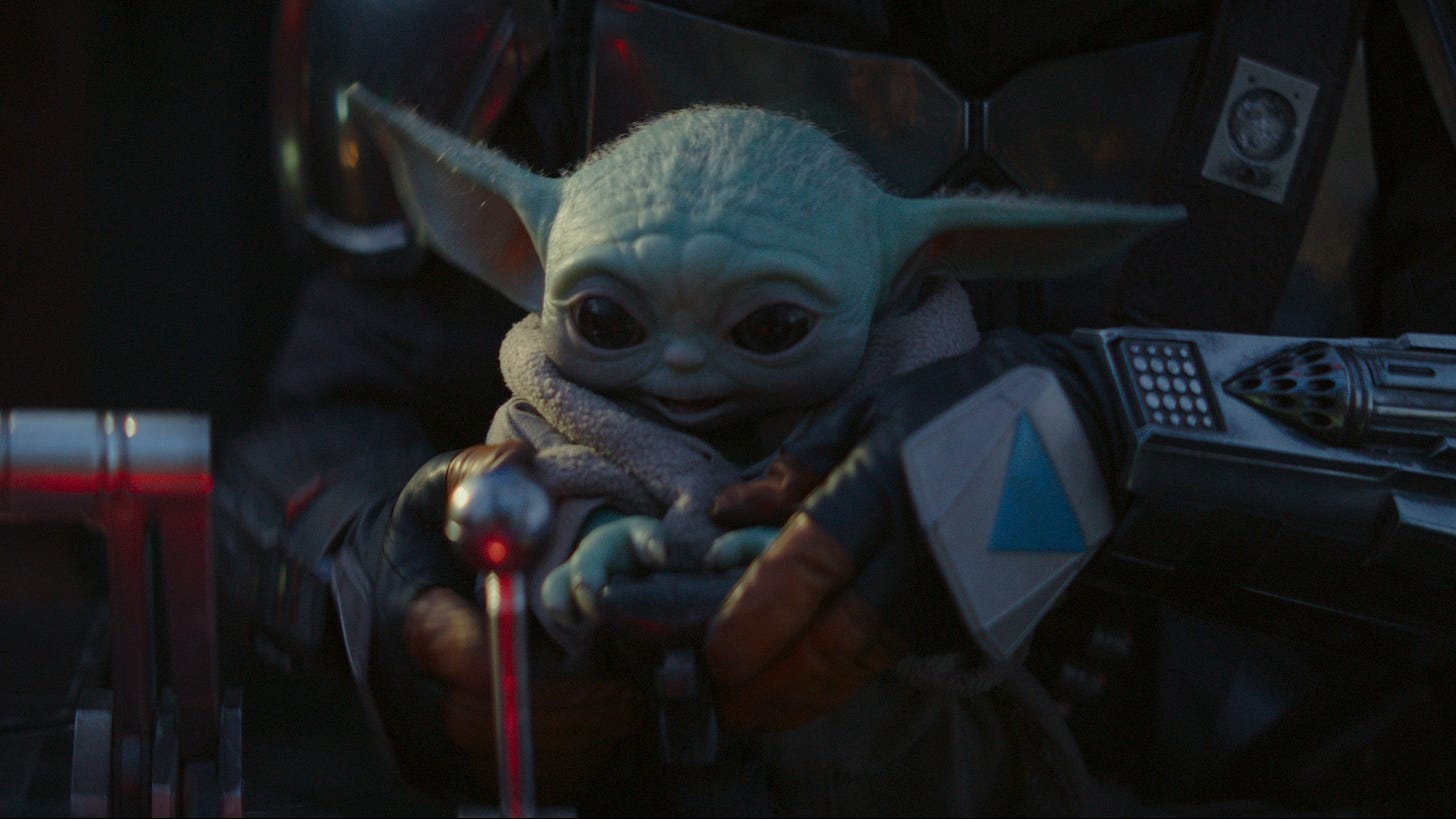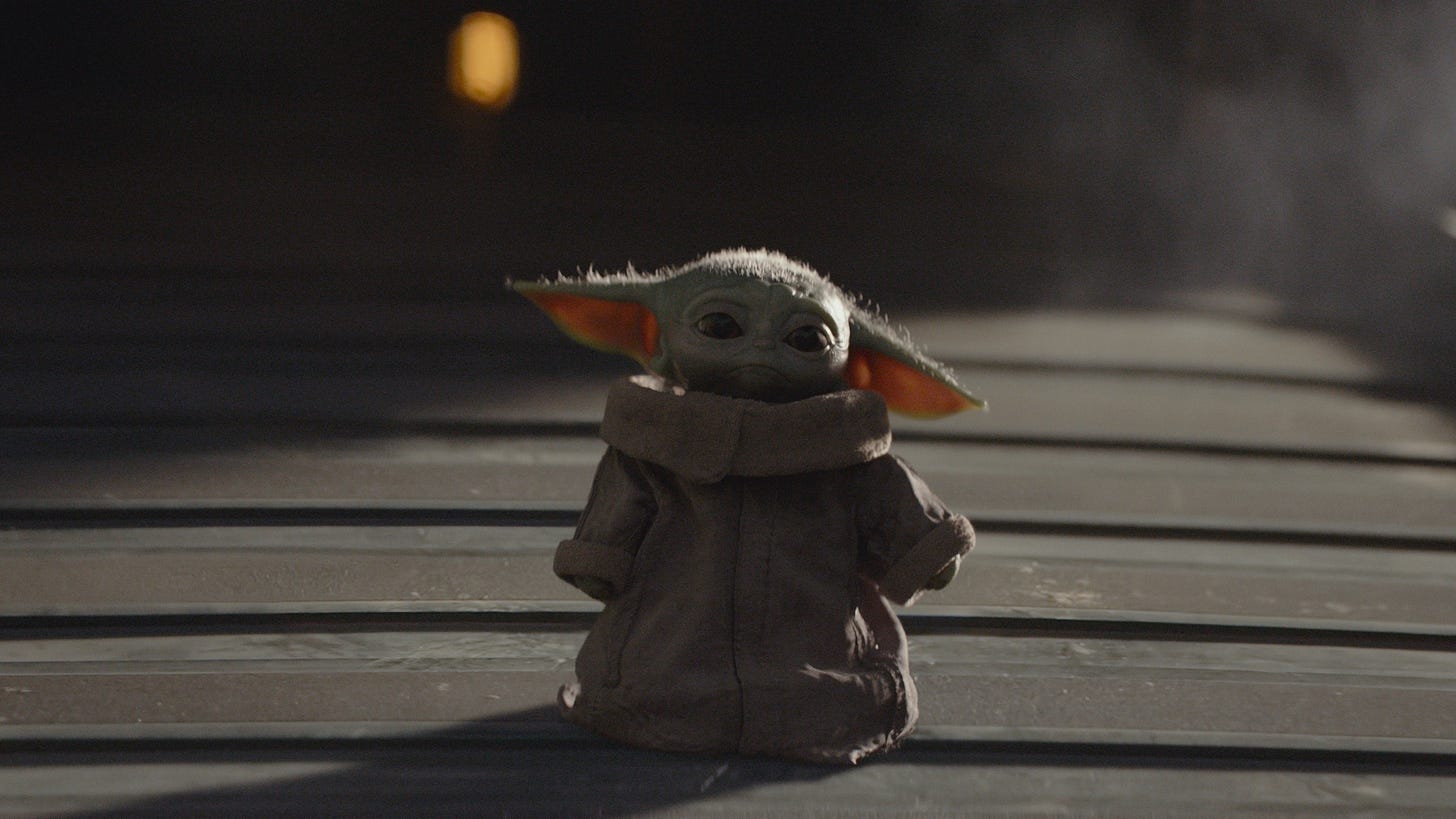When will Baby Yoda grow up?

Baby Yoda is a babbling, waddling, squee-inducing extraterrestrial designed to turn human adults into puddles of over-sweet spotchka. If we welcomed this super-powered swamp creature into our lives with open arms in 2019, his 2020 return for Season 2 of The Mandalorian feels like someone just threw a tiny green light into the Sarlacc pit of existence. Baby Yoda is a reminder that even now, there is pure, unadulterated goodness in this galaxy.
But at 50, he is also a very old baby.
And I for one can’t help but wonder how many years of bewitching, bug-eyed cuteness Baby Yoda’s got left. Eventually, his infantile charm will fade and Baby Yoda will grow up into, well, something like this. But when, exactly, will that happen? To scientifically answer this question, I turned to two authoritative sources: Wookieepedia, the fan-edited encyclopedia of all things Star Wars, and researchers who study the development of intelligent primates, including humans.
Caution: Mild spoilers for The Mandalorian ahead.
The Star Wars Wiki didn’t give me many clues. Baby Yoda, officially known as “The Child,” hails from a mysterious species with just three galactic representatives: the little womp rat himself, Jedi Grand Master Yoda, and Jedi Master Yaddle, a female who first appears in Star Wars: The Phantom Menace. The home planet of these wrinkled green beings is unknown; their society and culture are an enigma. We do know that Baby Yoda’s people can live incredibly long lives — the elder Yoda died at the ripe old age of 900 — and based on the three individuals we’ve seen, they appear to be a highly Force-sensitive species. We also know that Yoda classic attained the rank of Jedi Master when he was about 100 years old, although whether he was full-grown at that point or merely a precocious youngster isn’t clear.
More clues about Baby Yoda’s developmental state come from his behavior in The Mandalorian. His vocalizations appear to be limited to coos, squeaks, and giggles, and he enjoys putting objects in his mouth, both hallmarks of a bonafide baby. But in other ways, Baby Yoda is more mature. He seems to understand language when it’s spoken around him, and he’s pretty situationally aware, shutting his egg pod or hiding in pots at the first sign of danger. He’s also astonishingly skilled with the Force, levitating mudhorns, stopping walls of flame, and healing his comrades with apparent ease. From witnessing Force-sensitive grown-ups struggle to perform similar feats, we know that Baby Yoda’s Force displays require a great deal of mental discipline.

Caitlin Canfield, a developmental psychologist at the NYU Grossman School of Medicine, said that in human terms, Baby Yoda seems like a 12 to 18 month-old child. He “can walk, feed himself, and express interest in people, places, and things around him—all things that generally develop between a year and a year and a half,” Canfield wrote in an email. She said that Baby Yoda’s language comprehension is “possibly advanced for this age, but babies begin to understand words around 6 months and can respond to questions and follow simple instructions before they turn two.”
On the other hand, Baby Yoda’s ability to speak is clearly a bit delayed compared with humans. “Coos and squeaks are sounds we expect from the newborn stage, while we see the emergence of giggles around four months,” said psychologist Nicolette Noonan, who received a PhD from the University of Western Ontario studying infant language development. Canfield suggested that Baby Yoda’s language production skills “may be a little behind since he's been focusing on harnessing his Force powers.”
Child psychologist Angela Fenoglio said Baby Yoda’s empathetic displays—for instance, his use of the Force to heal an injured Greef Karga—are more on par with those of a three or four-year-old. “He’s clearly still working on his emotion regulation, though—these interactions drain him completely—which is consistent with the preschool age range,” Fenoglio wrote in an email.
Clearly, there’s room to debate just how baby-like Baby Yoda is. But whether he’s an infant or a toddler, the question remains: How fast will he grow up from here?
If we assume that 900 is a typical lifespan for his species, then at age 50, Baby Yoda has lived about 5 percent of his life. While that may sound like a lot of time to spend mostly recumbent in an egg pod, humans and other great apes also have unusually long childhoods, something scientists have tied, in part, to the fact that our big brains require a lot of time and energy to mature. Erin Kane, an ecologist and anthropologist at Boston University who studies orangutan development, felt that Baby Yoda’s developmental pace to date is “in line pretty well with the other great apes.”
If he continues to follow an ape-like path, it could be a while before Baby Yoda is an adult. Our brains continue to mature into our twenties, more than a quarter of the way through the average human life span of 72. Orangutans have even longer childhoods, with juveniles nursing intermittently through 7 or 8 years of age and only reaching adulthood around age 15 (roughly 40 percent of a typical orangutan lifespan). Researchers hypothesize that the orangutan’s slow maturation and extended nursing period help ensure juvenile survival in rainforests where food availability varies greatly from year to year. Whether Yoda will have a similarly stretched out youth may depend on what the food situation is like on his homeworld, Kane said.
One way or another, given the slow pace at which intelligent primates mature, it is hard to imagine that Baby Yoda will be all grown up in just 50 years (the age at which Yoda senior became a Jedi Master). Noonan thinks certain developmental milestones could be much farther out of reach: “Given [his] lack of maturity in language skills, and if we assume the same trajectory as human language, we might not expect to hear Baby Yoda’s first words until he is around 100 to 150 years old,” she said.
Language aside, Kane felt that Baby Yoda was a more advanced juvenile—closer to a seven-year-old human. But she still thinks it’ll be another a century before Baby Yoda’s full-grown, although he could start hitting puberty in two or three decades.
Of course, all of this assumes Baby Yoda is developing roughly as an ape would. But maybe he isn’t. Maybe a better point of comparison for his species’ life history would be the longest-lived animals on Earth, many of which aren’t even warm-blooded.
The longest-lived vertebrate on the planet, the Greenland shark, can survive for at least 272 years, according to a 2016 paper published in Science. But female Greenland sharks don’t reach sexual maturity until at least 134 years of age, nearly halfway through that tentative lifespan. Mapping this life history onto Baby Yoda’s presumed 900-year lifespan, it could take our tiny green friend many centuries to mature.
Then again, if Baby Yoda’s species is ectothermic, or cold-blooded, his development is likely to be temperature sensitive, as is the case for ectotherms on Earth. Perhaps Baby Yoda is a bit like the olm, a blind, cave-dwelling salamander that can live past 100. A 2010 study found that it takes juvenile olms about fifteen years to mature in their chilly cave environments, but an earlier study showed that the initial embryonic and larval development phases can be sped up considerably by raising the temperature. So perhaps, if the Mandalorian gets sick of having an unruly toddler on his hands, he should try putting Baby Yoda in an incubator.
With so many aspects of Baby Yoda’s biology a mystery, it’s difficult to say whether he will be fully grown in one century or in four. But it seems safe to conclude that Baby Yoda has many youthful years ahead of him. At the same time, Baby Yoda will continue to grow and develop in ways we can’t predict, and it would be best if there were some members of his own kind around to supervise. Kane worries that if Baby Yoda remains away from his people too long, he’ll miss out on forming key social bonds and learning the skills he needs to survive on his mysterious homeworld. “It’s possible he will need to spend some time when he comes back into contact with the rest of his species learning what it means to be a Yoda,” she said.

As much as I absolutely would watch Baby Yoda cavorting about the galaxy for another few centuries, for the little guy’s sake, I hope that he finds his way home.
Top image: Lucasfilm